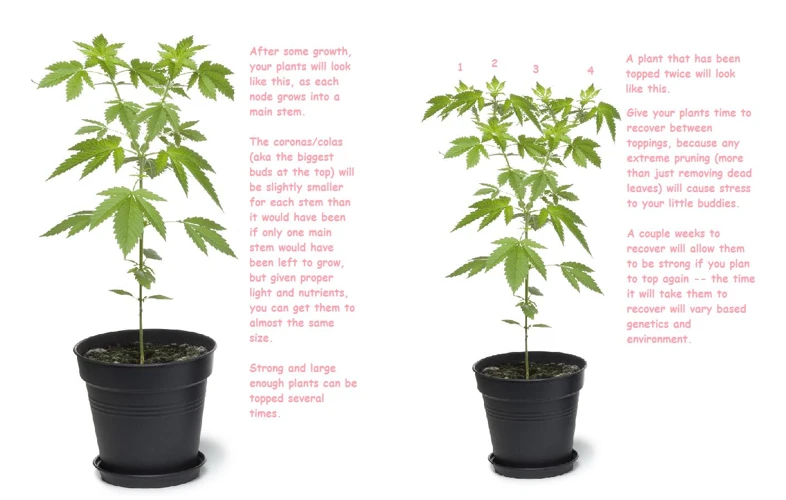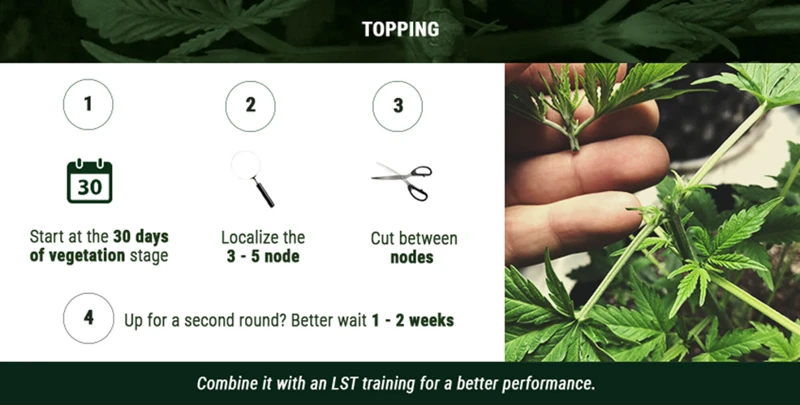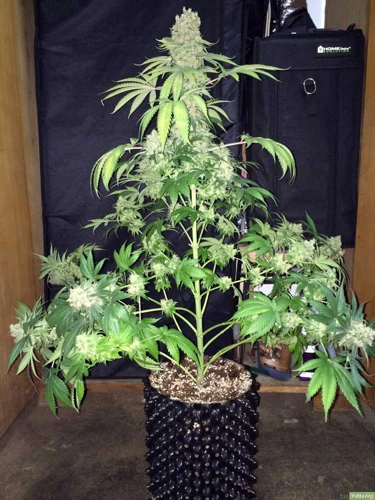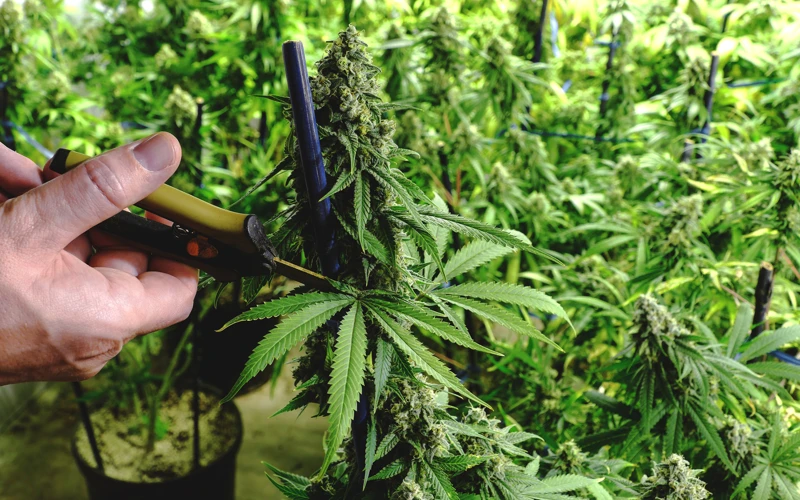
The Best Time to Top Your Marijuana Plant for Maximum Yield
As a marijuana grower, you may wonder when the best time is to top your plants. It’s a perplexing question that requires careful consideration of various factors. Topping your cannabis plant can increase its yield and improve its overall shape, but it can also stunt its growth if done at the wrong time. In this article, we will explore the what, why, and when of topping your marijuana plant. We’ll also provide a step-by-step guide on how to do it properly and tips on aftercare and maintenance. So let’s dive into the world of topping and unlock its potential for your cannabis garden.
What is Topping and Why is it Important?
Contents
If you’re new to growing marijuana, you may have heard of topping your plants, but you’re not quite sure what it means or why it’s important. Topping is a pruning technique used by many growers to increase yields and promote bushier growth. It involves cutting off the top of the plant and redirecting the energy towards lower branches. But why is it so important to top your marijuana plant? Let’s dive deeper into what topping is and explore its benefits.
What is Topping?
Topping is a pruning technique that involves cutting off the top of the main stem of a cannabis plant to encourage bushier, more even growth. This is accomplished by removing the apical meristem, which is the delicate tip of the plant that produces growth hormones and directs the plant’s growth upward. By removing this top section, the plant is forced to send resources to the lower nodes and branches, which allows for increased lateral branching, leading to a fuller and more productive plant.
The process of topping is performed by using sharp, sterile scissors to cleanly cut through the stem just above the fourth or fifth node. This should be done during the vegetative stage, before the plant begins to flower. Choosing the right time to top and ensuring proper technique are crucial to successfully utilizing this method for maximum yield and quality.
| Pros | Cons |
|---|---|
| Encourages bushier growth | May delay flowering time |
| Increases lateral branching | May increase stress on plant |
| Allows for more even canopy | Improper technique can damage plant |
Why is Topping Important?
Topping is a crucial activity for cannabis growers and it is essential for a successful harvest. Here are some reasons why topping is important for your marijuana plants:
- Increased Yield: By topping your plants, you can create multiple main colas and improve the overall yield. The plant will focus its energy on the growth of two main colas instead of one, so you will have more buds.
- Better Light Penetration: Topping your plant contributes to better light penetration and distribution. By doing this, more low-lying leaves can receive direct light which promotes enhanced photosynthesis and consequently better growth.
- Controlled Plant Height: Topping is an effective way to control the height of your cannabis plants. This is very useful especially if you are growing indoors, where height is a major issue. Topping the plant can help to control its height while still providing ample yields.
- Encourages Bushier Plants: Topping your plants ensures the growth of more branches which also encourages the growth of more leaves. This will, in turn, create denser and bushier plants which can produce a more abundant harvest full of big and healthy buds.
Topping enables growers to maximize the yield, control plant growth and encourage bushier plants. It is a crucial practice that helps to produce healthy, high-quality cannabis plants.
Factors to Consider Before Topping Your Cannabis Plant
When it comes to cannabis cultivation, there are many factors to consider before making any significant changes to your plant’s growth. Topping, the process of removing the plant’s main stem to promote lateral growth, can be an effective way to increase yields and improve the overall health of your plant. However, before you decide to top your cannabis plant, there are several crucial factors to take into account. These factors include the plant’s growth stage, strain type, and light cycle. By properly assessing each factor, you can ensure the success of your topping efforts and ultimately achieve a higher-quality harvest.
Growth Stage
One factor to consider before topping your cannabis plant is its growth stage. The optimal time to top your plant varies depending on the growth stage it is in. It is important to understand the growth stages of your plant in order to know when to top it.
Below is a table that outlines the different growth stages of a marijuana plant and when it is best to top it:
| Growth Stage | When to Top |
|---|---|
| Seedling Stage | Wait until it develops at least 2-3 sets of leaves before topping |
| Vegging Stage | When the plant has 4-6 nodes |
| Flowering Stage | It is not recommended to top during this stage as it can stress the plant and reduce yield |
As shown in the table, it is best to wait until the seedling stage is established with at least 2-3 sets of leaves before topping. This ensures that the plant has enough energy and nutrients to recover from the topping process.
In the vegging stage, it is recommended to top the plant when it has 4-6 nodes. This is when the plant has established its basic structure and topping it at this stage can encourage the growth of more branches and ultimately provide for a larger yield.
It is important to note that topping during the flowering stage can stress the plant and reduce your yield. It is best to avoid topping during this stage and focus on proper pruning and training techniques to ensure optimal growth and development.
Strain Type
When considering whether or not to top your cannabis plant, it’s important to take into account the strain type you are working with. Different strains have varying growth patterns, and some may respond better to topping than others. Here are some factors to keep in mind:
- Indica vs. Sativa: Indica strains are typically shorter and bushier, with thicker stems, while Sativa strains tend to be taller and leaner, with thinner stems. Indica strains may benefit more from topping, as it can help encourage lateral growth and increase yield. Sativa strains may be more challenging to top, as their naturally tall, thin structure may make them more prone to damage from pruning.
- Autoflowering vs. Photoperiod: Autoflowering strains have a predetermined life cycle that is not influenced by lighting, while photoperiod strains require a certain amount of light and darkness to trigger flowering. Autoflowering strains may not respond well to topping, as their life cycle is already limited and any stress can negatively impact growth. Photoperiod strains may be more conducive to topping, as it can help extend the vegetative stage and increase yield.
- Hybrid Strains: Hybrid strains are a combination of Indica and Sativa genetics, and can exhibit a variety of growth patterns depending on the specific genetics involved. It’s important to research the specific hybrid strain you are working with to determine whether or not topping is a viable option.
Strain type is just one of many factors to consider when deciding whether or not to top your cannabis plant. By taking into account the specific needs and growth patterns of your strain, you can make informed decisions that will help maximize yield and produce high-quality buds.
Light Cycle
The light cycle is an important factor to consider when deciding when to top your marijuana plant. Cannabis is a photoperiodic plant, which means that its growth and flowering cycles are regulated by changes in the amount of light it receives. This makes the light cycle one of the most critical factors to keep in mind when growing cannabis.
Here are a few points to keep in mind regarding the light cycle:
- Vegetative growth: During the early stages of its life cycle, a cannabis plant requires a light cycle of around 18-24 hours of light per day to promote vigorous vegetative growth. This is because the plant is focused on growing leaves and stems, which require a lot of energy from the sun.
- Flowering: When the plant is ready to start flowering, it needs a shorter light cycle of around 12 hours of light and 12 hours of darkness. This triggers the plant’s natural hormonal changes, causing it to produce buds instead of leaves and stems.
- Transition: When transitioning from the vegetative stage to flowering stage, some growers choose to give their plants a brief period of darkness for a day or two. This can help the plant prepare for the switch to a shorter light cycle and may lead to bigger yields.
One thing that is important to note is that outdoor growers are at the mercy of the natural light cycle, which can vary depending on the time of year and geographic location. Indoor growers, on the other hand, have more control over the light cycle and can manipulate it to suit their needs.
Keeping the light cycle in mind is critical when deciding when to top your marijuana plant. By understanding the plant’s light requirements at different stages of growth, you can give it the best chance of thriving and producing a bountiful harvest.
When to Top Your Marijuana Plant
One of the most important decisions a cannabis cultivator must make is when to top their plants. It can be a difficult decision because timing is crucial to achieving the desired results. Timing is dependent on several factors, including the plant’s growth stage, strain type, and light cycle. In this section, we will guide you through the best time to top your marijuana plants and why it’s important to get it right. So, let’s dive in!
When the Plant Has 4-6 Nodes
When the Plant Has 4-6 Nodes
One general rule of thumb when it comes to topping your marijuana plants is to top them when they have 4-6 nodes. Nodes are the points on the stem where leaves and branches grow, and they can provide important information on the overall health and growth of your plant.
Topping your cannabis plant at the 4-6 node stage is beneficial because it allows for a more even canopy and promotes lateral growth. By removing the top of the plant, you force it to redirect its energy towards the growth of new shoots and branches, which will in turn result in a fuller and bushier plant.
However, it’s important to note that not all strains of cannabis will respond well to topping at this stage. Some strains may require more time to develop before topping, while others may be ready to be topped earlier. It’s important to consider the specific needs of your strain and monitor the plant’s development closely.
| Pros | Cons |
| Encourages lateral growth | May not be suitable for all strains |
| Promotes an even canopy | Requires close monitoring of plant development |
| Results in a fuller and bushier plant |
Topping your marijuana plant when it has 4-6 nodes can be a beneficial technique for promoting lateral growth and creating a fuller plant. However, it’s important to consider the specific needs of your strain and monitor the plant’s development closely to ensure optimal results.
During the Vegetative Stage
During the vegetative stage of your marijuana plant, it is the perfect time to top your plant. This is because the plant is actively growing and developing its structure without the added stress of flowering. Additionally, topping during the vegetative stage allows the plant to recover and redistribute its energy towards growing more branches and foliage, which ultimately leads to a greater yield.
Factors to Consider:
Before topping your marijuana plant during the vegetative stage, there are several factors to consider. Firstly, you should ensure that your plant has at least four to six nodes, which are the points where the leaves grow out from the stem. This ensures that you will have enough room to work with and that the plant is mature enough to handle the topping process.
You should also take into consideration the strain type that you are growing. Some strains have a strong natural inclination towards bushiness, while others may grow more vertical. Understanding the growth pattern of your specific strain can help you decide where and how to top the plant.
Lastly, it is important to ensure that your plant is receiving the proper light cycle for its growth stage. During the vegetative stage, your plant requires 18-24 hours of light per day. This allows it to grow quickly and develop a strong structure to support the upcoming flowering stage.
Benefits of Topping:
Topping during the vegetative stage has several benefits for your marijuana plant. By pinching off the top growth, you are effectively halting the upward growth of the main stem, and triggering the plant to grow two new branches. These two branches will grow upwards and begin to form their own nodes, creating a fuller and bushier plant. This will ultimately lead to a higher yield when it is time to harvest.
How to Top Your Marijuana Plant During the Vegetative Stage:
To top your marijuana plant during the vegetative stage, you will need a clean and sharp pair of scissors or shears. First, identify the stem just above the fourth, fifth, or sixth node, depending on the height of your plant. Using your shears, cut the stem cleanly and precisely, leaving no more than 20% of the stem attached.
Once you have topped your plant, you should see two new shoots developing from the site of the cut within a few days. These new shoots will ultimately become new branches, and your plant will begin to grow more bushy and full.
Aftercare and Maintenance:
Following the topping process during the vegetative stage, it is important to monitor your plant’s growth and development closely. You may need to adjust your growing techniques to accommodate the new growth pattern, such as adjusting the support structure to handle the increased weight of the new branches.
Proper pruning techniques, such as removing any leaves blocking the new shoots, are crucial to ensure that your plant continues to grow correctly. Additionally, you may need to train and support the new growth by using methods such as trellising or tying down the branches to encourage horizontal growth and prevent them from growing too tall.
Topping your marijuana plant during the vegetative stage is a crucial step in maximizing your yield. By considering the appropriate factors before taking the plunge, carrying out the topping process correctly, and implementing proper aftercare and maintenance, you can ensure that your marijuana plant grows into a healthy and bountiful harvest.
Before the Plant Flowers
When deciding when to top your cannabis plant, one crucial factor to consider is doing it before the plant flowers. This is because once the plant begins to flower, any drastic changes such as topping can cause it to experience stress and jeopardize the quality and yield of your harvest.
| Factors to Consider | Details |
|---|---|
| Timing | You should top your plant around 4-6 weeks before the start of the flowering stage. This timing allows enough time for the plant to recover from any stress before the flowering stage begins. |
| Plant Size | It is best to top your plant when it has reached a height of at least 18 inches. This allows for enough space to create new growth and for the plant to strengthen its structure. |
| Bud Site Development | Before topping, observe the plant for the development of bud sites. You will want to make sure that the topping occurs above the first node that will eventually develop into a bud site. |
It is crucial to remember that the flowering stage is the most crucial one for cannabis plants. Any stress can negatively impact the plant’s ability to produce high-quality buds. Topping your plant at the right time and with the right technique is crucial for a healthy and productive harvest.
How to Top Your Marijuana Plant
Now that you know when to top your marijuana plant, it’s time to learn how to do it properly. Topping your cannabis plant can seem daunting, but with the right tools and techniques, it can be a straightforward process. In this section, we’ll go over the tools and materials you’ll need, as well as a step-by-step guide on how to top your cannabis plant. Follow these instructions carefully, and you’ll soon be on your way to a healthier and more productive cannabis plant.
Tools and Materials Needed
In order to properly top your marijuana plant, you will need a few tools and materials. The following table outlines the necessary items:
| Tool/Material | Description |
|---|---|
| Pruning shears | Sharp scissors or shears that can easily cut through the stem of the plant. |
| Rubbing alcohol | An antiseptic solution that can be used to sterilize your pruning tool to reduce the chances of infection on your plant. |
| Gloves | Latex or nitrile gloves can be used to protect your hands from becoming contaminated with harmful pathogens that could harm the plant. |
| Plant ties | Soft ties or string that can be used to tie your plant down as it grows to prevent it from falling over or breaking. |
| Clean workspace | A clean and sanitized workspace is essential for maintaining the health of your plant. |
Having these tools and materials on hand before you begin will help make the process of topping your marijuana plant much easier and ensure that you do not accidentally damage or hurt the plant during the process. It’s also recommended to wear gloves and use rubbing alcohol to sterilize your pruning shears to prevent the spread of disease and infection to your plant.
Step-by-Step Guide to Topping Your Cannabis Plant
Step-by-Step Guide to Topping Your Cannabis Plant
Topping your cannabis plant might seem like a daunting task, but it is actually relatively simple if you follow these steps carefully. Here is a step-by-step guide to topping your marijuana plant:
| Step 1: | Ensure your plant is healthy and well-nourished. If your plant is stressed, topping can cause more harm than good. |
| Step 2: | Wash your hands and disinfect your pruning tools with rubbing alcohol to avoid introducing any bacteria or pathogens to your plant. |
| Step 3: | Identify the location where you will make your cut. You should be aiming to remove the top part of the stem just above the fourth node. |
| Step 4: | Make a clean cut with your sterile pruning shears just above the fourth node, being careful not to damage the surrounding leaves or stem. |
| Step 5: | Dispose of the removed growth or use it for cloning if desired. |
| Step 6: | Water and feed your plant as per usual, and monitor it closely in the coming days to ensure the plant is responding well. |
Remember, topping your marijuana plant is a delicate process that requires patience and care. Take your time with each step, and do not rush any part of the process.
Aftercare and Maintenance
Now that you’ve successfully topped your marijuana plant, it’s important to ensure that it grows healthy and strong. Proper aftercare and maintenance can help your plant reach its full potential, producing high-quality buds with maximum yields. This stage of the plant’s growth requires careful monitoring, frequent pruning, and specialized training techniques. By following the right practices and providing the necessary support, you can help your cannabis plant thrive and produce the best possible results. In this section, we’ll take a closer look at the key aspects of aftercare and maintenance for your topped marijuana plant.
Monitoring Growth and Development
Once you have topped your marijuana plant, it’s important to monitor its growth and development regularly. Here are some tips to help you keep your plant healthy and thriving:
- Observe the Plant: Regular observation of your plant can help you identify any potential issues early on. Look out for discoloration, wilting, or any abnormalities in growth.
- Check Soil Moisture: Make sure to check the soil moisture regularly. Over-watering or under-watering can harm the plant’s growth. Maintain an appropriate level of moisture as per the plant’s needs.
- Trim Excess Leaves: Remove any unwanted leaves and stem that obstruct or shade downwards. Ensuring that the plant has enough air flow and light can help it grow better.
- Provide Adequate Light: Insufficient light can stunt the growth of your plant, while providing intense light can lead to bleaching or scorching of the leaves. Provide the right amount of light for optimal growth.
Keep in mind that different strains may have different growth patterns and requirements, so it’s important to research the strain you’re growing and provide it with the necessary care.
By following proper growth and development monitoring practices, you can ensure that your plant is healthy and thriving, and produce high-quality buds for consumption.
Proper Pruning Techniques
Pruning is an essential aspect of cannabis cultivation that can impact the overall health and yield of your plants. In order to successfully top your marijuana plant, it is important to have a solid understanding of proper pruning techniques.
1. Start with Clean Tools: Before you begin pruning your marijuana plant, make sure that your tools are clean and sharp. Dirty or dull tools can increase the risk of infection, and may damage the plant.
2. Identify Problematic Areas: Examine your plant carefully and identify any areas that are damaged or diseased. These areas should be removed immediately to prevent further spread of the problem.
3. Cut at a 45-Degree Angle: When pruning your marijuana plant, make sure to cut at a 45-degree angle. This will help to promote healing and prevent damage to the plant.
4. Don’t Remove Too Much: It is important to avoid removing too much from your marijuana plant at once. This can cause stress and shock to the plant, and may create more problems than it solves.
5. Know When to Stop: It can be tempting to continue pruning your cannabis plant, but there is a point where you should stop. Keep in mind that removing too much can impact the overall yield and health of the plant.
6. Use Sterilized Blades: In order to prevent the spread of infection, make sure that your pruning blades are sterilized between uses. This can be done using rubbing alcohol or a sterilizing solution.
7. Seal Large Wounds: If you are removing a particularly large or significant branch from your marijuana plant, it is important to seal the wound. This can be done using a sealant or even honey, which can promote healing and prevent infection.
By following these proper pruning techniques, you can ensure that your cannabis plant remains healthy and strong throughout the growing process.
Training and Support
Training and support are crucial for the healthy growth and development of your marijuana plants after topping. This process involves manipulating the plant’s growth patterns to ensure that it stays strong and healthy. Here are some ways to achieve training and support:
| Method | Description |
| LST (Low Stress Training) | This method involves gently bending and tying down the plant’s branches to encourage lateral growth and more even canopy development. |
| HST (High Stress Training) | This method involves more aggressive bending and tying of the branches and can result in faster growth and higher yields, but also poses a greater risk of damage to the plant if not done carefully. |
| Staking | Sometimes marijuana plants can become top-heavy after topping, so staking is a helpful method to keep them upright and support their stem and branches. |
| Trellising | This method involves using horizontal support structure with netting or wire to help support the weight of the branches and encourage even growth. |
Remember to always be gentle with your plants and avoid causing any unnecessary stress during the training and support process. With proper care, training, and support, your marijuana plants can thrive after topping, resulting in a bountiful harvest.
Conclusion
In conclusion, topping your marijuana plant can be a beneficial technique for promoting bushier, fuller growth and increasing yield. However, it is important to carefully consider several factors before deciding to top your plant, including the growth stage, strain type, and light cycle.
Once you have determined that topping is right for your plant, it is crucial to follow the proper techniques and procedures to avoid damaging or stunting its growth. This includes selecting the right tools and materials for the job and following a step-by-step guide for topping your plant.
Aftercare and maintenance are also essential for ensuring the success of your topped marijuana plant. This includes monitoring its growth and development, using proper pruning techniques, and providing training and support as needed.
Remember, topping your marijuana plant is just one technique that can be used to promote healthy growth and increase yield. It is important to research and consider other techniques as well, such as low stress training and defoliation. By taking a holistic approach to cannabis cultivation, you can help ensure the best possible results for your plants.
Frequently Asked Questions
What are the benefits of topping my marijuana plant?
Topping stimulates lateral growth, increasing yields and creating a bushier plant with more colas.
Is topping my marijuana plant necessary?
No, it is not necessary, but it can greatly improve the quality and quantity of your harvest.
At what growth stage should I top my marijuana plant?
The plant should have 4-6 nodes before it is topped.
Can I top my marijuana plant during the flowering stage?
No, it is not recommended to top your plant during flowering as it can stunt growth and diminish yields.
What tools and materials do I need to top my marijuana plant?
You will need sharp pruning shears, rubbing alcohol or hydrogen peroxide, and a clean, flat surface to work on.
What is the best time of day to top my marijuana plant?
It is best to top your plant in the morning when the plant is fully hydrated and has the most energy.
What should I do if I accidentally remove too much of the plant while topping?
If you remove too much of the plant while topping, it is best to stop pruning and let the plant recover before attempting to prune again.
How often can I top my marijuana plant?
You should only top your plant once per growth cycle to avoid stressing the plant too much.
What do I need to do to care for my plant after topping?
You will need to monitor the plant closely and continue with proper maintenance techniques such as pruning, training, and support.
What strain types are best suited for topping?
Most hybrid strains are well-suited for topping as they respond well to stress and can produce a plentiful harvest.






